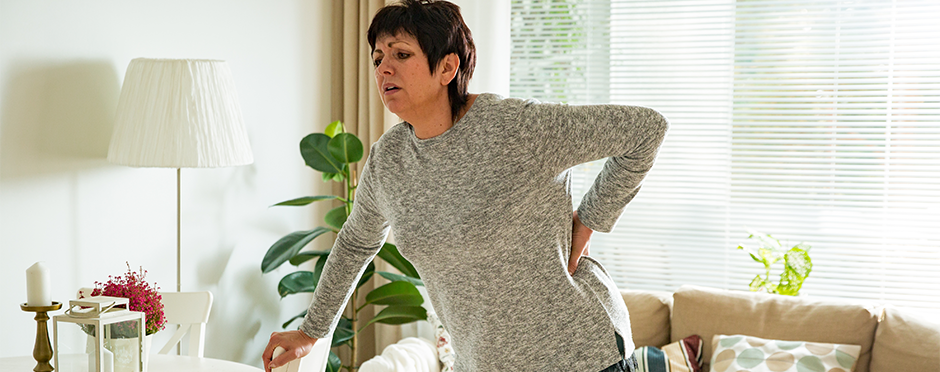
Treating Your Back Pain Forever
1 CommentIn our modern day world where we find ourselves increasingly commuting longer distances by car to spend days rooted to a desk or computer, followed by a return commute, afternoon driving kids to practices and attending meetings, and an evening on the couch in the company of televisions, tablets, and smartphones, it is not a mystery why our backs may feel tight. And, more importantly, why the best treatment may not be stretching.
While it cannot be discounted that all of us would certainly benefit from a few back stretches to combat the flexed position of our sedentary lifestyle, treating back pain solely with stretching provides temporary relief and is the reason I frequently hear patients state “my back is still tight.” What is interesting is just how often this remark is followed by, “and stretching doesn’t help.” Curious? Keep reading to learn how to alleviate perpetual back tightness.
First, it is necessary to understand the CAUSE of back tightness, or a majority of muscle tightness in general. Muscle tightness is often the symptom resulting from sustained positions and continuous muscle contraction. As bipedal human beings our back muscles have an endurance role, acting as the “guywires” providing stability and holding us erect throughout the day. This task is not easy, and many of our backs are simply not up to the task resulting in the guarding and tightness we feel, a repercussion of these muscles “fighting” to keep our spines vertical. Therefore, the best treatment may not be back stretching, but back strengthening.
Back Strengthening
Prior to commencing back strengthening, it is important to reiterate that, as spinal stabilizers, back muscles have a primary endurance role, acting to support the spine in vertical throughout the day. Therefore, they must be trained according to their function and progressed first according to time and repetition, then resistance. Back pain should not result from performance of an exercise.
Superman
Engage your back and abdominal muscles and slowly raise your arms, chest and legs off the ground. Ensure your back and abdominal muscles remain engaged throughout the exercise and avoid arching your back. Activation should be felt in the muscles along the length of your spine and not in the center of your back. Hold this position for 5-10 seconds and then return to start. Perform 2-8 repetitions.
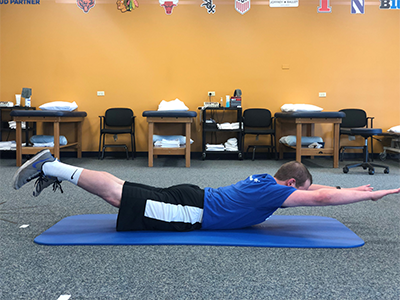
Stability Ball Quadruped Arm/Leg Raise
Lie on your stomach over a stability ball with your arms and feet resting on the ground. Engage your back and abdominal muscles and simultaneously straighten one arm and the opposite leg until they are parallel to the floor. Hold briefly then return to the starting position. Repeat with opposite arm and leg. Ensure back and neck do not arch; keep chin tucked during the exercise.
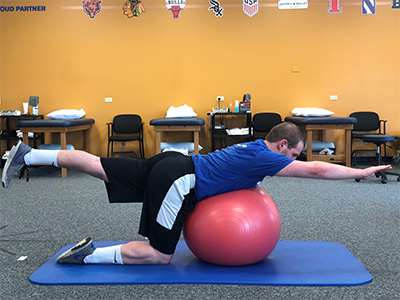
Abdominal Strengthening
Equally, if not more importantly, abdominal strengthening is an essential component in back pain treatment. As the opposing muscle group, these muscles act as spinal stabilizers supporting the front of the spine. In addition, the abdominals protect the back from excessive load and repetitive micro trauma. Similar to the back muscles, the abdominals should be strengthened according to their role as stabilizers and progression on time and repetition before resistance is best. Back pain should not result from performance of an exercise.
Plank
Lie on your stomach with forearms resting on ground in front of you. Engage your abdominal muscles and lift your hips off the ground supporting yourself by propping on your elbows and toes in a plank position. Ensure your back remains straight, elbows are under shoulders, and chin is tucked. *To decrease difficulty, perform exercise on knees.
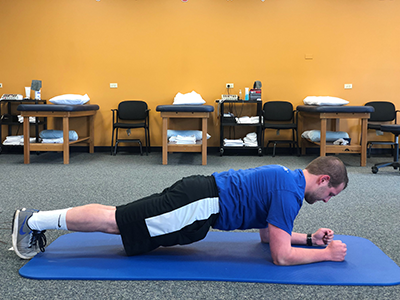
Side Plank
Lie on your side with elbow bent on ground underneath shoulder, other arm supported along top side, and feet stacked. Engage your abdominal muscles and lift hips off floor until body is in a straight line. Ensure hips and shoulders remain facing forward, body does not rotate, and hips do not drop toward floor. Hold for 20-60 seconds. *To decrease difficulty, perform exercise on knees.
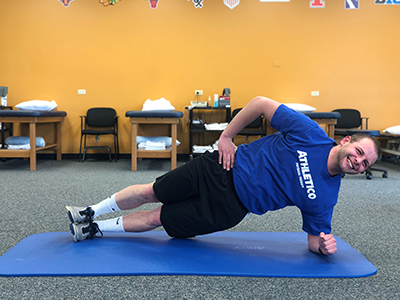
TA Isometric
Lie on back and bend knees, bringing hips toward chest until they are slightly above parallel. Rest your hands on your thighs and gently push your thighs into your hands, meeting the resistance by pushing your hands into your thighs until you feel abdominal muscles engage. Ensure pressure remains light, avoid pushing into thighs with excessive force so activation is felt in the hip. Continue breathing normally during exercise and ensure back remains flat against the floor.
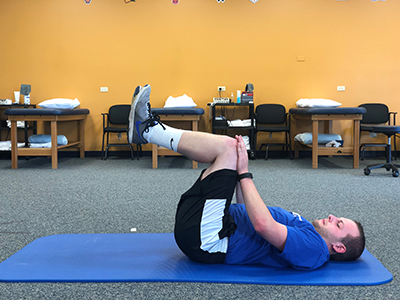
Lower Extremity Stretching
A further consequence of our sedentary lifestyle, lower extremity muscle tightness, is also a component comprising an effective back rehabilitation program as these muscles have attachments on the spine and pelvis and therefore influence spinal position. Muscles prone to tightness (and those correlated with low back pain) include the hamstrings, hip flexors, and quadriceps.
Stretching to improve muscle mobility is beneficial. Strengthening the opposing muscle group is also beneficial as tightness may develop due to guarding, which can occur when a muscle needs to compensate for a weaker one that is unable to meet the required demand. All stretches should be performed two times on both sides and held for 30-40 seconds in a comfortable range.
Hamstring Stretch
Stand with involved leg straight and other leg to side. Hinge at hips and lean forward until a stretch is felt in back of leg. Ensure knee remains straight, toes upright and avoid bending the back.
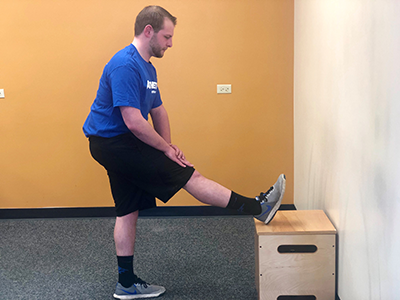
Quadriceps Stretch
Lie on your stomach with legs straight and strap looped around involved foot. Hold the other end of the strap in your hand on the same side. Pull the end of the strap forward to bend your knee toward your back until a gentle stretch is felt in front of thigh. Ensure your back does not arch during the stretch.
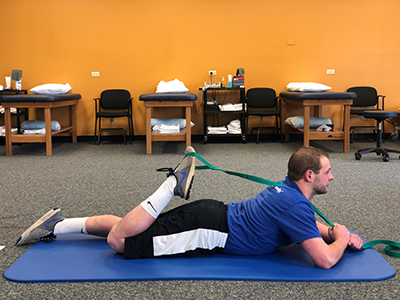
Hip Flexor Stretch
Kneel on the involved knee in a half kneeling position with other foot resting on floor in front of body. Tighten abdominals, tilt pelvis backward, and gently push hips forward until a stretch is felt in front of the hip. Ensure back remains straight during the exercise and avoid leaning forward.
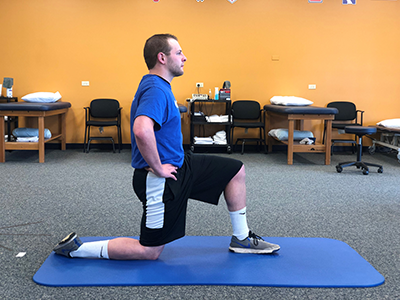
Back Stretching
The final requirement of a comprehensive back program, and the reason you chose to read this article, a few beneficial back stretches to incorporate. All stretches should be performed two times on both sides and held for 30-40 seconds in a comfortable range.
Prayer Stretch
Begin in a kneeling position resting on your heels. Bend and reach your arms forward, resting palms on ground, and lower your chest to the ground. Continue breathing normally during exercise and gradually sink into the stretch.
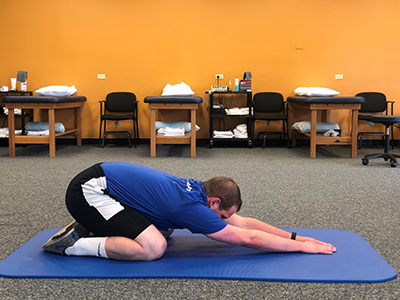
SB Flexion Stretch
Sit on a chair and rest hands on a large stability ball in front of you. Reach forward, rolling ball forward until stretch is felt in back.
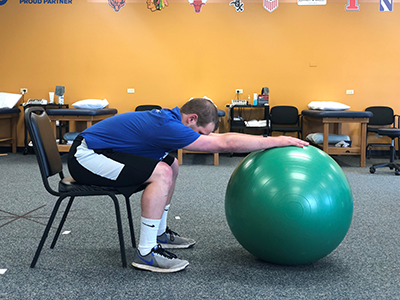
Latissimus Dorsi Doorway Stretch
Stand in a doorway with your feet against the side of the doorframe on the uninvolved side and grasp the edge of the doorframe overhead on the same side. Keeping your feet firmly against doorframe/ground, lean away from the doorframe until a stretch is felt on the opposite side.
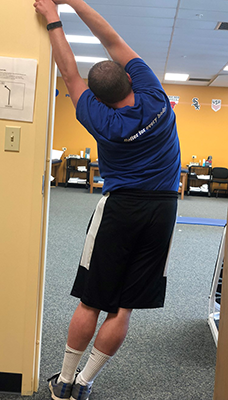
Comprehensive Back Pain Treatment
With knowledge that a truly effective back rehabilitation program involves more than back stretching, and is incomplete without back and abdominal strengthening and lower extremity stretching, you may discover back stretching is no longer as paramount.
If you have questions or concerns about your back pain, schedule a free assessment at your nearest Athletico clinic so our experts can take a look at your pain and provide recommendations for treatment.
The Athletico blog is an educational resource written by Athletico employees. Athletico bloggers are licensed professionals who abide by the code of ethics outlined by their respective professional associations. The content published in blog posts represents the opinion of the individual author based on their expertise and experience. The content provided in this blog is for informational purposes only, does not constitute medical advice and should not be relied on for making personal health decisions.

1 Comment
Ashley
I liked that you said that one thing to consider when you are experiencing back pain is to engage in exercises that will resolve the issue. I have been experiencing back pain from work but I haven’t been sure how to fix it. I will be sure to consider engaging in a good exercise in order to relieve myself of discomfort.